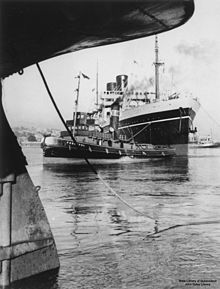Comorin
|
||||||||||||||||||||
|
||||||||||||||||||||
|
||||||||||||||||||||
|
||||||||||||||||||||
|
||||||||||||||||||||
The Comorin (I) was an ocean liner put into service in 1925 by the British shipping company Peninsular and Oriental Steam Navigation Company (P&O), which was used in passenger and mail traffic between Great Britain and Australia and later India . During the Second World War , the Comorin served as an auxiliary cruiser until it burned out in the North Atlantic on April 6, 1941 and was sunk by shell fire the following day.
Passenger ship
The 15,116 GRT steamship Comorin was commissioned in 1923 together with two identical sister ships . The Comorin and the Cathay (15,104 GRT) were built at Barclay, Curle and Company in Glasgow and both launched on October 31, 1924. The third ship, the Chitral (15,248 GRT), was built at the Alexander Stephen and Sons shipyard, also located in Glasgow, and was launched on January 27, 1925.
The three ships each had two funnels, two masts and two propellers and were propelled by two four-cylinder quadruple expansion steam engines with an output of 13,000 PSi and a cruising speed of 16 knots. The ships were designed to carry 203 first-class passengers and 103 second-class passengers. The Comorin was baptized by Lady Margaret Mackay Shaw when she was launched . She was the wife of Alexander Shaw, 2nd Baron Craigmyle, a board member of P&O.
On April 11, 1925, the Comorin was the first of the three ships to be handed over to the shipping company after the test drives . Then she went on her maiden voyage to Australia . On March 12, 1930, a fire broke out on board while the Comorin was in the port of Colombo ( Ceylon ). In the same year a Wyndham heating system and low-pressure turbines from Bauer-Wach were installed, increasing the achievable speed to 17 knots. The passenger quarters have also been renovated. From then on she drove mainly from Bombay to the Far East . In July 1937, the ship was in Singapore the Union Jack painted on the ship's side to make it in Chinese-Japanese Second War to make it easier to identify.
War effort
On September 5, 1939, the Comorin was requested by the British Admiralty for service as an armed auxiliary cruiser (Armed Merchant Cruiser). The rear funnel was dismantled to make room for seven 152 mm cannons and two 76 mm cannons. On December 30, 1939, she began her new service with the tactical ID F49. The ship's commanding officer was Captain John Ignatius Hallett, a holder of the Distinguished Service Order , for the remainder of his service . From January to April 1940 the Comorin was employed at the South Atlantic Station, from May 1940 in the Bermuda Convoy Escort Force and from March 1941 in the Freetown Escort Force.
On April 6, 1941, the Comorin caught fire with 470 people on board at position 54.34N, 21.20W off the coast of Sierra Leone . All but 20 could be picked up by the motor ship Glenartney , the British destroyer Lincoln and the flotilla leader Broke . The Broke went alongside the burning Comorin so survivors could jump over. The fire could not be brought under control. On April 7, 1941, the Comorin was sunk by shell fire from the Lincoln .

